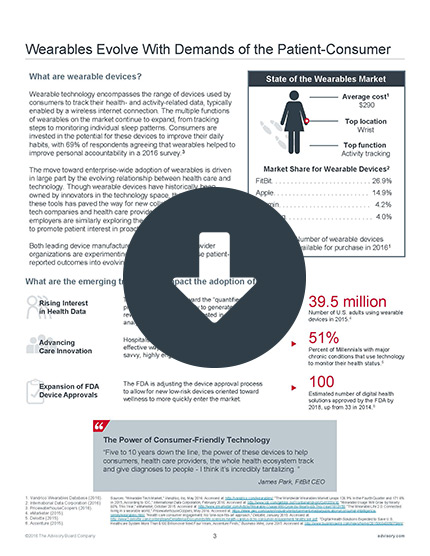Auto logout in seconds.
Continue LogoutFitbit activity trackers can help doctors track how much post-operative patients walk after surgery, and the data reveal that more steps, up to a certain point, correlate with lower odds of long hospital stays, according to a study by researchers at Cedars-Sinai Medical Center published recently in JAMA Network Open.
Webconference: Get the latest general surgery market trends for 2019
How the researchers counted patients' steps
"Decades of research" shows that patients' ambulation after surgery can play a "central role" in their recovery—but patients' ambulatory status remains a "neglected component" of patient care, according to the researchers.
To close this gap, researchers at Cedars-Sinai Medical Center set out to quantify patients' ambulation after major surgery using Fitbit devices. The researchers gave Fitbit watches to 100 adult patients who had undergone one of eight major inpatient operations, including hip replacements and gastric bypass, at Cedars-Sinai Medical Center between July 2016 and August 2017. The researchers instructed the patients to wear the Fitbits throughout the duration of their hospitalization except for when they showered.
To encourage the patients to walk, the researchers gave them an app that includes tours of the Cedars-Sinai art collection. The app included short and long tours that had specific step counts.
The patients' daily step counts were "passively monitored" through the Fitbit watches, as well as by surgeons who estimated each patient's ambulation when they performed daily rounds, the researchers wrote. Each patient's data were uploaded and analyzed after they were discharged.
For each 100 extra steps, patients were less likely to have a long stay (up to a point)
An analysis of the patients' Fitbit data found that, for up to 1,000 steps, every 100 steps a patient took the day after surgery reduced the probability that the patient would have a prolonged length of stay by 3.7%. There was no significant reduction in the probability of a prolonged length of stay beyond 1,000 steps per d ay, the researchers noted.
The researchers said the results suggest that patients should strive to meet a 1,000-step daily goal immediately after an operation, similar to the 10,000 step daily goal that Fitbits and other wearables encourage for people who are healthy.
"While we cannot assume that the association between digitally monitored postoperative step count and LOS is causal, our findings provide the critical foundation for future interventional studies by identifying a clinically meaningful (if ambitious) daily step count goal," the researchers wrote.
Are wearable monitors the next big tool for health care workers?
If the use of Fitbit activity trackers catches on for post-surgical patients, step count could "become a sixth vital sign for surgical teams," the study authors wrote.
"We measure everything about our patients—whether it's heart rate, blood pressure, etc.—but nowhere do we measure steps, even though we know steps are so important for a patient's well-being. Now we have the ability to do so," according to Brennan Spiegel, senior author of the study and director of the Center for Outcomes Research and Education.
Thomas Krummel, a thoracic surgeon and co-director of the Stanford Byers Center for Biodesign, in an accompanying commentary said the researchers' use of the Fitbit to track patient ambulation is "only the beginning" of "an entirely new world of real-time data acquisition, monitoring, and intervention." He added that using wearable activity models will allow health care facilities to "measure, track, and understand patient physiological data and behavior both in the hospital and at home," and possibly "alert patients, nurses, and physicians instantaneously" (Commins, HealthLeaders, 2/6; Daskivich et al., JAMA Network Open, 2/1; Farr, CNBC, 12/2/17).
Your telehealth cheat sheet on wearables
Wearable technology encompasses the range of devices used by consumers to track their health- and activity-related data. As the multiple functions of wearables on the market continue to expand, consumers are becoming more invested in the potential for these devices to improve their daily habits. Wearable technology can help to facilitate patient activation and improve clinical outcomes.
The cheat sheet details how rising interest in health data, advancing care innovation, and expansion of FDA device approvals has impacted the adoption of wearables.
Don't miss out on the latest Advisory Board insights
Create your free account to access 1 resource, including the latest research and webinars.
Want access without creating an account?
You have 1 free members-only resource remaining this month.
1 free members-only resources remaining
1 free members-only resources remaining
You've reached your limit of free insights
Become a member to access all of Advisory Board's resources, events, and experts
Never miss out on the latest innovative health care content tailored to you.
Benefits include:
You've reached your limit of free insights
Become a member to access all of Advisory Board's resources, events, and experts
Never miss out on the latest innovative health care content tailored to you.
Benefits include:
This content is available through your Curated Research partnership with Advisory Board. Click on ‘view this resource’ to read the full piece
Email ask@advisory.com to learn more
Click on ‘Become a Member’ to learn about the benefits of a Full-Access partnership with Advisory Board
Never miss out on the latest innovative health care content tailored to you.
Benefits Include:
This is for members only. Learn more.
Click on ‘Become a Member’ to learn about the benefits of a Full-Access partnership with Advisory Board
Never miss out on the latest innovative health care content tailored to you.


